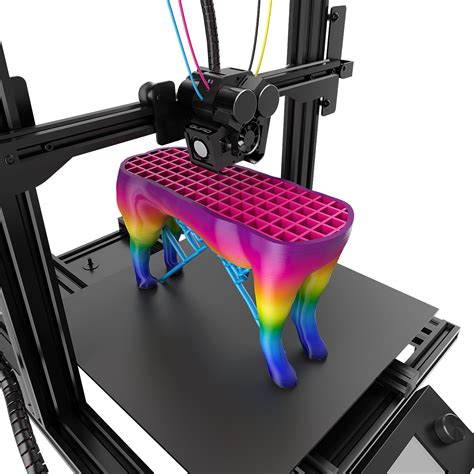Understanding 3D Printing Technology
Before diving into the specifics of choosing a 3D printer, it’s essential to understand the basics of 3D printing technology. 3D printing, also known as additive manufacturing, is the process of creating three-dimensional objects by depositing materials layer by layer. There are several types of 3D printing technologies, each with its own advantages and limitations.
Types of 3D Printing Technologies
- Fused Deposition Modeling (FDM)
- Stereolithography (SLA)
- Selective Laser Sintering (SLS)
- Digital Light Processing (DLP)
- Multi Jet Fusion (MJF)
Factors to Consider When Choosing a 3D Printer
When selecting the Best 3D Printer for your needs, there are several key factors to consider:
Print Quality and Resolution
Print quality and resolution are crucial aspects to consider when choosing a 3D printer. The resolution, measured in microns, determines the level of detail and smoothness of the printed objects. Higher resolutions result in more precise and detailed prints, but they also increase printing time and cost.
| Technology | Typical Resolution (microns) |
|---|---|
| FDM | 50-400 |
| SLA | 25-100 |
| SLS | 80-120 |
| DLP | 25-150 |
| MJF | 80-120 |
Build Volume
The build volume refers to the maximum size of objects that a 3D printer can produce. Consider the dimensions of the objects you plan to print and ensure that the printer’s build volume can accommodate them.
Material Compatibility
Different 3D printers support various materials, such as PLA, ABS, PETG, nylon, and resin. Each material has its own properties, strengths, and weaknesses. Choose a printer that is compatible with the materials best suited for your intended applications.
Ease of Use and Reliability
Consider the user-friendliness and reliability of the 3D printer. Look for features like automatic bed leveling, filament detection, and a user-friendly interface that simplifies the printing process. Additionally, consider the printer’s reliability and the availability of customer support and community resources.
Price and Value
3D printers come in a wide range of prices, from entry-level models to high-end professional machines. Determine your budget and consider the value offered by each printer in terms of features, performance, and long-term costs (e.g., maintenance, consumables).
Top 3D Printer Recommendations for 2023
Based on the factors discussed above, here are our top recommendations for the best 3D printers in 2023:
1. Prusa i3 MK3S+
The Prusa i3 MK3S+ is a highly respected FDM 3D printer known for its excellent print quality, reliability, and ease of use. It features automatic bed leveling, filament detection, and a wide range of material compatibility.
2. Formlabs Form 3
The Formlabs Form 3 is a professional-grade SLA 3D printer that delivers exceptional print quality and detail. It is ideal for applications that require high precision, such as dental and jewelry production.
3. Creality Ender 3 V2
The Creality Ender 3 V2 is an affordable and popular FDM 3D printer that offers great value for its price. It features a heated bed, a user-friendly interface, and a large community of users for support and resources.
4. Ultimaker S5
The Ultimaker S5 is a high-end FDM 3D printer designed for professional use. It boasts a large build volume, dual extrusion capabilities, and advanced features like a touch screen interface and remote monitoring.
5. Anycubic Photon Mono X
The Anycubic Photon Mono X is a high-resolution DLP 3D printer that delivers excellent print quality at an affordable price point. It is well-suited for printing small, detailed objects like miniatures and jewelry.

Frequently Asked Questions (FAQ)
1. What is the best 3D printer for beginners?
For beginners, the Creality Ender 3 V2 is an excellent choice due to its affordability, ease of use, and large community support.
2. What materials can 3D printers use?
3D printers can use a variety of materials, including PLA, ABS, PETG, nylon, and resin. The specific materials supported depend on the type of printer and its specifications.
3. How much does a good 3D printer cost?
The cost of a good 3D printer varies depending on the type of technology, features, and intended use. Entry-level FDM printers can start at around $200, while professional-grade machines can cost several thousand dollars.
4. Can 3D printers print metal objects?
Some specialized 3D printers, such as those using Selective Laser Melting (SLM) or Direct Metal Laser Sintering (DMLS) technologies, can print metal objects. However, these printers are typically more expensive and complex than standard FDM or SLA printers.
5. How long does it take to 3D print an object?
The printing time depends on various factors, such as the size and complexity of the object, the resolution, and the printing technology used. Small, simple objects can take a few minutes to print, while larger, more complex objects can take several hours or even days.
Conclusion
Choosing the best 3D printer in 2023 requires careful consideration of factors such as print quality, build volume, material compatibility, ease of use, and price. By understanding your specific needs and priorities, you can select a 3D printer that will deliver the best results for your projects. Whether you’re a hobbyist, educator, or professional, investing in a high-quality 3D printer can open up a world of possibilities for creative expression and innovation.






Leave a Reply